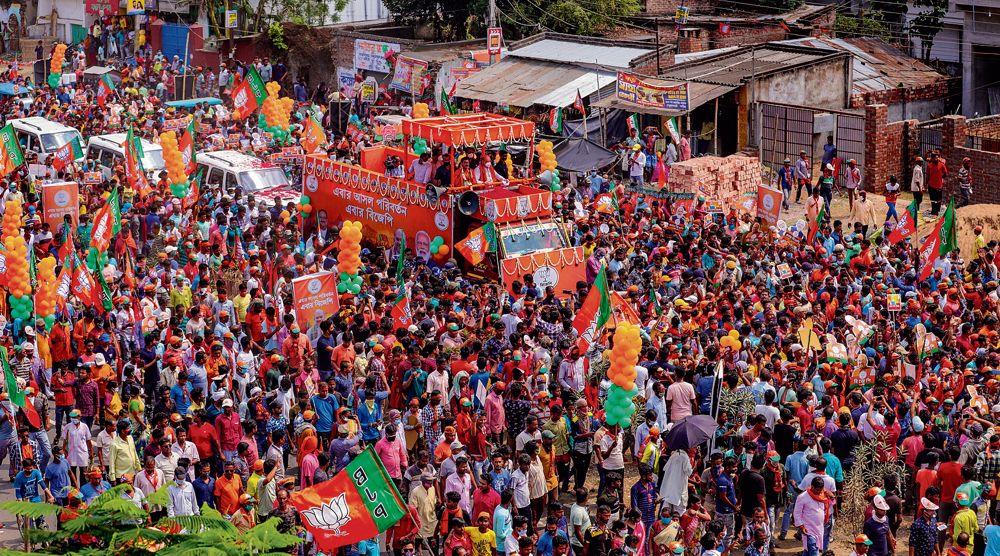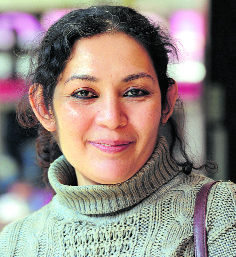
Powder keg: The BJP’s poll strategy has polarised Bengal on communal lines as never before since Independence. PTI
Saba Naqvi
Senior Journalist
One could pun that the West Bengal elections are indeed ‘super-spreaders’, spread out as they are over eight phases of polling. But the serious question is inevitably linked to the spread of coronavirus and whether there is a political price to be paid for the large human gatherings that have been mobilised for the polls up to the fifth round of voting. Middle class and media outrage have now compelled the parties to state that they are curtailing the size of the crowds (BJP), minimising the time of the campaign (Trinamool Congress) or ceasing the in-person rallies altogether (Congress) and taking the campaign online and door-to-door (CPI-M).
But since the architecture and pitch of this ongoing Bengal campaign has been determined by the BJP, it’s worth exploring how the national party views the scenario in the backdrop of India breaking records in Covid infections but persisting with election mobilisation. We are acting in ways that defy common sense: there is a huge shortage of vaccines and the already poor health system is broken, yet not a word from the authorities against the mega gathering of millions at the Kumbh mela in Hardwar.
But will it matter in the electoral reckoning? In Bengal, the BJP does not believe that Covid has become an issue except in urban pockets and that too in a particular section of society, from which the media is also drawn. The suffering and desperation caused by the disease, amplified on social media, they say, is not a reality in Bengal. The BJP’s principal gains are being made in the countryside among a rural population voting for change where the virus has not yet spread on an alarming scale.
Therefore, the party does not believe that it will damage it in the ongoing state elections (although after each phase of polling, health data shows a rise in coronavirus infections).
The BJP’s cynical calculation, therefore, is that should there be a virus surge in the hinterland, it would come once the polls are over. In the meantime, the party believes, that as a non-traditional player in Bengal, it must not slow the campaign momentum at all. And, that is why the flurry of visits of national BJP leaders will not cease till the last day of campaigning.
If the narratives of the Covid miseries and disaster in BJP-ruled states have not penetrated the Bengal countryside, it’s because it’s not a lived experience and by the time it may be so, the elections would be over.
The BJP is relying on that, having tasted political blood. The TMC is literally and metaphorically injured with leader Mamata Banerjee soldiering on with her leg injury. But it must be stated that just as disasters don’t seem to damage Narendra Modi’s image, Mamata too remains more popular than her party.
The May 2 results can be analysed to see if indeed the sudden surge in Covid infections impacted the BJP’s performance, but that could also be put down to different demographies and local dynamics in the very diverse state.
Fundamentally, whatever the outcome, it would still be wise to see Bengal 2021 as an Assembly election where people are voting for a state regime or against it. The strong messaging by national leaders of the BJP is designed to make the party look like a potential winner as people vote for new forces only if they mark a presence.
Some of the support that the BJP is getting draws from a desire for change and accumulated anger with the so-called ‘syndicates’ — that is individuals who get their clout from being in the structure of the TMC and extracting a price for any job to be done. The BJP has essentially filled in the Opposition vacuum after the TMC went about systematically decimating the old opposition of the Left.
Yet, the party has undeniably also taken the election in an altogether different direction. First, the BJP played a very interesting brand of cultural politics in Bengal, reaching out to subaltern groups, enhancing their sense of sub-identity and promising them political clout if they vote as a caste group. This is now one of the tried and tested techniques in the Hindutva handbook of creating a new citizen/voter. But it also reveals interesting contradictions.
The ultimate stated aim of the RSS (expressed by its overwhelmingly Brahmin leadership) is the utopia of a casteless society. But on the ground, this is actually being done through enhanced caste awareness. The BJP/RSS methodology is fascinating in that it does give some marginalised groups a sense of inclusion and purpose, howsoever fleeting. The stage one of the process would be identity assertion, stage two a sense of inclusion (however imperfect and temporary) as everyone is handed a banner and told to mobilise through cries of ‘Jai Shri Ram’; and then comes stage three that involves polarising against the ‘other’ — in this case, Bengal’s very large Muslim population.
As the wheels of the BJP electoral machine turn, by the time this battle is lost or won, the state would have been polarised on communal lines as never before since Independence. That’s the powder keg in the election, the sentiment created by narratives of supposed Muslim entitlement and appeasement, along with the familiar tropes of cattle-smuggling, love jihad et al, in districts bordering Bangladesh.
It has not yet reached the level of persistent and settled hatreds as visible in Uttar Pradesh, but a beginning in that direction has certainly been made. Whatever be the rate of coronavirus infection, the contagion of communalism has certainly spread on the fault-lines of Bengal’s history, partitioned twice: in 1905 and 1947.
There is a section of the Kolkata society that argues that news of the disastrous Covid situation in BJP-ruled Gujarat and Uttar Pradesh has also opened a front for anti-incumbency against the national party. There is, however, no convincing proof, beyond a few opinions, that a certain ‘Covid anti-incumbency’ could be building or that there are separate types of incumbency, divided between the Centre and the state. That may just be the view of a section of society in Kolkata that sees the BJP leaders as outsiders who are wrecking everything that contemporary Bengal stood for.
Join Whatsapp Channel of The Tribune for latest updates.




























